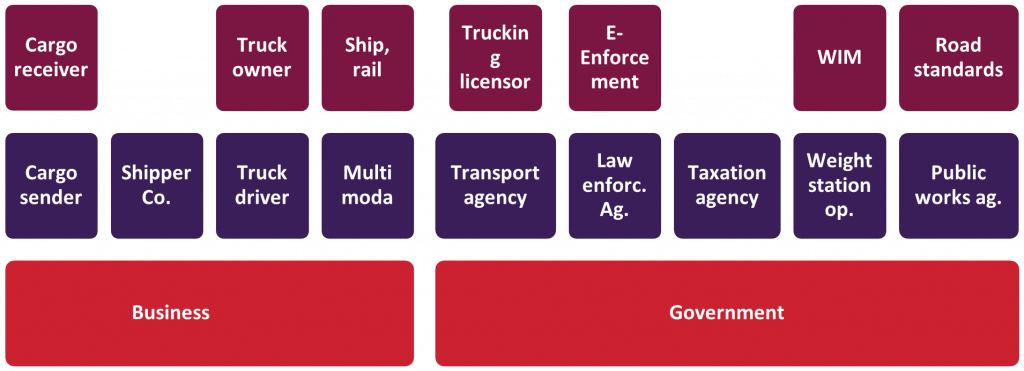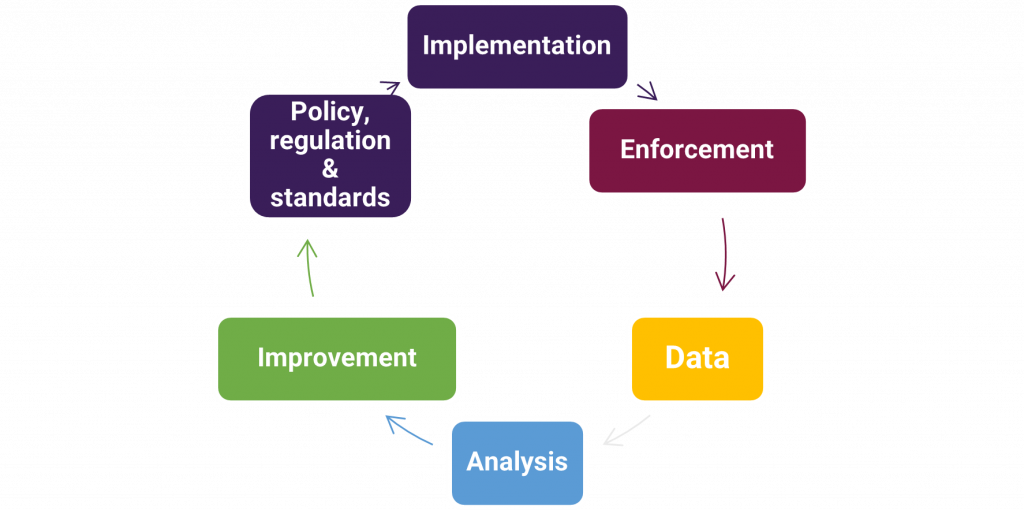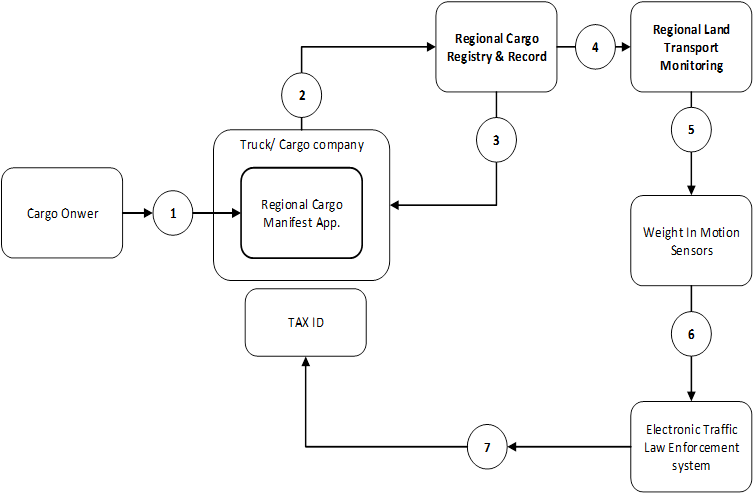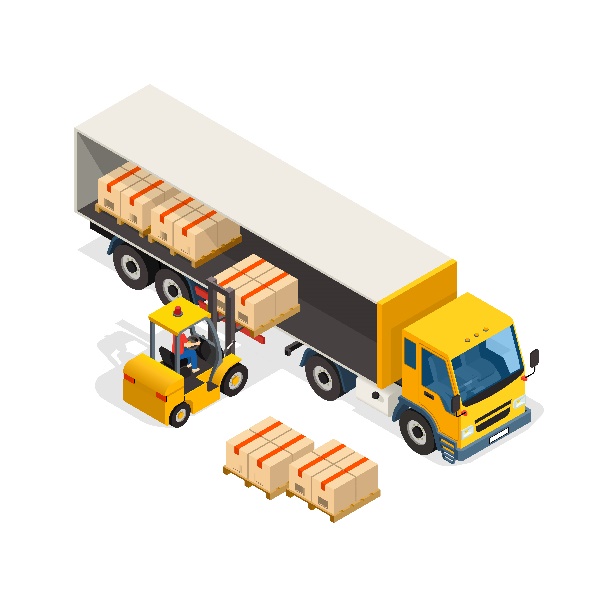Countries invest in road infrastructure even though is expensive and time consuming to construct because infrastructure is critical to support economic growth. Globally, countries are facing lower revenue and financial capability, meaning maintaining existing infrastructure has become more important.
Land logistics are dominated by trucks, but overloaded trucks are destroying the infrastructure, increasing maintenance and repair costs. Damaged roads then also increase the logistics costs and reduce smooth trade. This also reduces the infrastructure’s lifetime, resulting in investment quality reduction.
This policy brief suggests taking a digital approach in expanding the stakeholders of the trucking eco system, rethinking the regulations and standards to accommodate infrastructure and newer truck technology. It also suggests rethinking the effectiveness of violation enforcement and data capture with electronic road charging (ERC) and parcel containerisation.
Challenge
The global pandemic has changed business practices globally. Most countries and governments are now faced with raw material shortages, less tax revenue and low domestic spending as an effect of the global economic disaster brought on by the pandemic. Today the new norm is less physical attendance and more digital everything. Business meetings to develop trade in physical and nonphysical goods are now conducted virtually instead of through physical meetings.
Nonphysical goods can be software, consultations or any other kinds of digital products and services. Delivery of these nonphysical goods and services may not need the travelling of the people involved. Physical goods on the other hand, will still need to be sourced, manufactured, stored and delivered between places. For most countries, the logistics sector plays a vital role in the country’s economic growth and development. The development of the logistics sector facilitates international trade, increases the competitiveness of countries and thus is seen as an important determinant of growth and development (Hayaloglu, 2015).
The global value chain dictates that each supply chain must contribute to the value of a business in terms of service quality, speed and cost. The quality of transportation and logistics infrastructure is a source of comparative advantage for industries in which logistics services are important (Rodrigue, 2021). Transportation infrastructure and logistics are important inputs in the supply of goods within a country, in the sourcing of raw materials and in the delivering the finished goods domestically and internationally.
Developed countries have invested heavily in transportation and logistics infrastructure construction and have large expenditure for the maintenance and rehabilitation (M&R) of existing infrastructure. The M&R costs are necessary to maintain the service quality of the infrastructure for the economy. Developed countries have suppressed road M&R costs by reducing the number of overweight trucks but many developing countries still experience high road damage costs due to this issue.
Many studies suggest that the major cause of M&R costs is damage caused by overweight trucks (Gunarta, n.d.). Overweight trucks also affect road safety and contribute to road accident fatalities as braking distance and truck maneuverability is significantly reduced and reducing the ability to avoid collision. (Chan, 2008).
Indonesia reported that in 2018, truck overweight and over-dimension problems amounted to more than US$3 billion in infrastructure loss (Arnim et al., n.d.). Although not considering M&R cost, China’s traffic management agencies reported that by the end of 2005, there were 11.69 million overloaded vehicles nationwide (Jun & Bensman, 2009). The overloading of trucks in Europe pushed Hungary to invest in reliable weigh-in-motion (WIM) technology. The same problem in the United States triggered a number of studies, such as on facilitating trade between Mexico and the US (Ronay-Tobel, 2022).
Group of 20 members are still recovering from the pandemic and have limited financial capacity to fund M&R costs for the existing infrastructure, let alone for new infrastructure investments. This has forced governments to reduce the M&R costs for existing infrastructure by reducing the damage caused by overloaded trucks, while encouraging nationwide logistics activity to recover the economy. The ability to reduce infrastructure M&R costs while maintaining optimal functioning determines a government’s own confidence and investor’s trust in future transportation and logistics infrastructure expansion.
Proposal
Digital integration platforms should be used to connect the regulators, shippers, carriers, infrastructure keepers, road users and stakeholders of truck logistics to share the responsibility for proper and efficient use of logistics infrastructure.
The proposed concept requires establishing the following components:
1. Electronic Road Charging (ERC)
ERC is an ecosystem of integrated regulation and policy, interconnected digital technology platforms, standardisation, effective road user management, infrastructure investment and digital law enforcement to collect revenue and information from road infrastructure usage.
Figure 1. ERC workflow
ERC consist of the following set of systems:
1.1. ERC digital truck permit
An ERC digital truck permit (DTP) is a truck operating permit that can be accessed online and through mobile apps by the truck’s owner or operator and the road authority. The DTP must be renewed annually, where it connects to the truck’s vehicle identification number (VIN), license plate, truck type, color, owner, manufacturer date, registered gross vehicle weight, dimensions, axle, maximum weight and all periodic inspections including on emissions and safety such as brake and suspension inspection.
Law enforcement has full access to DTP data using registered mobile devices and connected road cameras using a weight measurement system to correctly and effectively enforce regulations and fine violators using an electronic traffic law enforcement (ETLE) system.
G20 members have different truck sizes and categories that are already regulated by each country. A cross- border data exchange of each country’s ERC DTPs could help identify cross-border trucks and allow access to the appropriate roads and supporting the pick-up and unloading of cross-border cargo shipments as the DTP contains information about a truck’s category, thus the route can be managed according to the country’s road classifications.
DTP truck classification is based on the road classification of a country. DTP data are stored in the National Transportation Data and can be used by multi-government agencies as the basis for their respected policy and strategy. Road designers usually calculate the road usage using equivalent standard axle load (ASEL), a Wisconsin study in 1999 observed that rural interstate highways attributed to 40 percent of the axle excess load and road damage.
1.1.2. Electronic traffic law enforcement
ETLE is a key component in connecting road regulation violations with road users and ensuring the penalty or fine for a violation is addressed to the correct person or company. ETLE should not be designed primarily to collect revenue but to encourage regulation compliance and discourage violations because the imposed violation penalty amount should be so high that everyone will comply to avoid paying the penalty. The ETLE concept can be as simple as on-street digital parking tickets to the highly sophisticated application in multi-line free flow (MLFF) toll violation charging system. Cities or countries that already operate an ETLE system can expand the existing vehicle data to accommodate charging from the DTP and WIM captured violations.
1.1.3. Weigh-in-motion networks
WIM technology measures vehicle weight while a vehicle is moving. This technology has already improved from only being able to measure vehicle weight while static to being able to measure trucks and
other vehicles while moving. WIM sensors should be installed along toll roads, strategic logistic paths and at selected traffic lights to measure passing truck weight. Installation along non-toll roads is necessary for trucks using regular roads to avoid paying toll fees.
The WIM sensors connect to ERC DTP databases and the ETLE system. Hungary is one country that has successfully implemented such a system, called the TSM system, comprising WIM sensors, automatic number plate readers (ANPRs) cameras, speed detection and violation charging (Ronay-Tobel, 2022). Every passing truck’s license plate and axle weight is captured by WIM sensors and is sent to the ERC system. The ERC system compares WIM data with the registered DTP and current cargo permit number (CPN). If there is a mismatch, then the ERC system issues a violation ticket and notifies the truck owner and driver through their mobile app.
WIM networks send violation data to the ERC system for processing with a detailed camera image, recorded vehicle weight, recorded violation and detected license plate number. As the license number will be connected to vehicle registration data, the ERC will send the ticket to the truck owner and driver according to DTP data through the ETLE system. The ETLE system will then send a notification to the truck owner and truck driver’s application for notification and reply. This entire process should be completed in less than two minutes when the ticket note reaches the driver’s mobile application and the traffic police patrol. If the ticket is not replied to or challenged within a certain number of days, then a fine is permanently attached to the truck owner’s tax identification.
G20 governments may instituionalise the ERC and the ETLE as separate entities or merge them into one institution. The important thing is to make sure the process is doable in a short amount of time and fits the government’s financial abilities.
1.2. Parcel Containerisation
Before containers became the standard in the shipping industry, all transported goods were bulk packed in boxes, bags, barrels or other small containers depending on the type of cargo. Managing this type of cargo took time and labour to load and unload. There were also many cases of lost goods caused by theft and damage. In the 1960s, containerisation became popular following the effectiveness and savings shown by US companies using standard military containers that could be stacked in ships (Fitzgerald, 1986). It proved that ships using containers could carry more cargo more securely than ships with bulk cargo.
Overweight and overloaded cargo in trucking happens during the loading process onto trucks.
During cargo onloading there is always a tendency to add as many goods as possible into the cargo container spaces or onto the open-top truck. In an open-top truck, overloading cargo sometimes adds more than two times the maximum height of the truck, make it dangerously unstable. In closed containers or trucks, pushing cargo inside until it is full can make the loaded truck or container weigh beyond its permissible weight.
Figure 2. Parcel Containerisation illustration, attribute to freepik
We suggest introducing a parcel container (PACT) concept. PACT is a standardised small container or box that can be weighed using common weight measurement equipment. PACT size measurements will fit evenly into standard shipping container. PACT containers or boxes can be made from any hard material constructed in standardised PACT measurements and can be be weighed before loaded to the truck.
There will be debate about the correct size and material of the PACT, but as happened in the shipping industry, eventually people will reach a consensus and will use the current shipping/truck container size as reference, with ease of lifting by small forklift or by hand. Shippers can build their own, rent or buy PACTs. Each PACT should have a PACT identification number from the national cargo manifest registry and record with the detailed dimensions, materials, production year and maximum weight capacity. The ERC mobile app will calculate and store each parcel’s weight loaded into the trucks. If it exceeds the truck’s maximum load, then the system would not issue the CPN.
1.2.1. Cargo manifest apps and cargo permit numbers
A cargo manifest app is an online application to apply for a CPN. CPN data contain the truck’s DTP, the driver’s professional data, the total PACT or cargo volume and weight. Cargo manifest app data will be filled by the cargo carrier and shared with the cargo shipper, connecting to national logistics data. The app will pull the truck’s DTP data and compare it with the total cargo weight or PACTs loaded on the truck. The CPN is only released if the total weight of the cargo or PACTs is consistent with the truck’s DTP, thus preventing overloading during the truck loading process.
Overloading cargo during loading process also happens when workers are not well trained and do not properly arrange the cargo. Governments can distribute the PACT containerisation application for free, which can simulate the total weight and placement of each cargo container or PACT inside the truck or container. With this application, the total weight of all cargo and PACTs would not exceed the truck’s capacity as stated in the truck’s DTP.
CPN data contain the truck’s DTP information, the truck driver ID, cargo manifest ID and the total final weight recorded in the cargo’s CPN approval. If a truck passing a WIM sensor is captured with a weight exceeding the DTP maximum, then the system will notify the driver and record a violation.
1.2.2. National logistic data centre
National logistic data (NLD) centres store the cargo permit applications and release the CPNs. The data are important for analysing existing infrastructure usage, economic growth, ongoing policy, existing trade, potential economic growth and formulating effective strategies for infrastructure investment that creates economic growth in each country and region. The truck traffic and weight contained in CPN data provides cumulative annual ESAL numbers that, when compared with each road’s ESAL design data, provide accurate predictions of potential road damage and what governments can do about it.
1.3. Standardisation and regulation
Depending on a government’s growth and economic strategy, land logistics with trucks is a major factor in a country’s economic growth. Advances in suspension, truck frames, axles, tyres and engines allows trucks to carry more weight safely. Infrastructure also has experienced much technological advancement such as road technology and safety that allows roads to withstand more weight
This requires governments to periodically review road standards and capabilities and truck standardisation. Considering a country’s unique regional conditions, if the region is in need of economic growth, then the ERC should be postponed to ensure that the logistics costs remain low. Each country may have different regulations regarding truck categories and related maximum weight. The maximum weight is decided through a calculation of a road’s class category along with its construction and estimation, which can also be estimated with the ESAL. The ESAL figure is based on the constructed road design and can be used to predict the damage to a road based on the number of trucks passing over it.
1.3.1. Inclusive stakeholders expansion strategy
Transportation is part of culture because it is part of the people’s daily life across regions, and logistics supply chains using trucks are a major part of the transportation that provides people with daily goods. Trucks are the primary method of distribution for the production, components of production and the distribution of resulting daily goods. Yet trucks share the road with regular road users, who also suffer the damage to roads caused by overweight trucks.
Naturally, cargo shippers and carriers will load as much as they can in every truck shipment, seldom will they consider the truck’s condition, limitations, the road conditions and the road damage caused by overweight trucks. The public must be included as stakeholders of infrastructure investment and take proactive action.
It is important to expand the number of stakeholders in the trucking ecosystem, socially and legally. We need to add cargo owners, cargo receivers, truck drivers, truck owners and shippers into the policy and regulation as stakeholders of the logistics activity so they can share the benefits and the responsibilities to maintain government investment in the infrastructure.

Figure 3. Stakeholder expansion of ERC ecosystem
1.3.2. Adaptive and iterative policy approach
In dealing with overweight trucks, there are three responses: do nothing, increase enforcement or upgrade the infrastructure (Chan et al., 2006). Different countries have different economic strategies that emphasise their natural and strategic advantages. The strategy will be reflected in the infrastructure investment and deployment. Developing countries may still invest in infrastructure with the common goal to provide the lowest logistics costs possible but do not consider externalities such as M&R for damaged infrastructure. Developed countries may already consider overall safety as the priority. However, given that in a vast country, economic conditions may not be uniform inside its borders, there may be region that are already highly competitive while other regions still need a lot of government support.
Transportation is a dynamic field because there is always newer technology and improvements in road paving that can increase a road’s capacity to handle more vehicle weight, newer technology includes truck suspension designs that allow trucks to carry heavier loads on each axle and other innovations that contribute to higher road ability and longer durability.
Full enforcement is a critical factor in controlling vehicle weight and functions as a deterrent. Governments should fully execute a strict enforcement policy if needed. Implementation results will be recorded by an integrated digital platform and will be used as a basis for policy analysis. The resulting analysis would be the updated input for future policy, regulations and standards (PR&S).

Figure 4. Adaptive transportation and logistics regulatory platform
The iterative process allows governments to adapt to the changing domestic and international business conditions to support the country’s economic activities. For example, if a region has been troubled by road damage, ERC data analysis may prove that because of the logistics activities in that area, heavier and larger trucks are needed, or that there is limited activity in an area, but most of the trucks passing through are overloaded. The other solution may be to used truck with more axles. Certainly, the decision and updated PR&S will be different in the management of each region. This interactive process allows governments to manage the conditions of different regions and issue effective policy and infrastructure funding to accommodate each region’s economic activities while improving overall international logistics competitiveness.
1.4. Policy
G20 members should apply different policies for their respective regions to best serve their regional development. For example, a regional government in a densely populated area may opt to upgrade the
road infrastructure and increase compliance because the region needs more supplies and experiences more risk by allowing bigger, more unsafe trucks to use the busy road. The same country may also do nothing about the existing road conditions and overweight trucking in another region. The reason being that to boost the economic activity in that area, the government needs the low logistics costs resulted from overloading and overweight trucks, even if it damages the infrastructure (Jun & Bensman, 2009). After the economic activities in those area increase, the government can then impose new policy to protect the infrastructure investments and begin to upgrade the infrastructure.
1.4.1. Enforcement
Enforcement is a critical factor to control vehicle weight (Board, 1990). Enforcement will upset the balance of low cost M&R damaged infrastructure with reduced economic activities because of high logistics costs and strict overweight enforcement. It does not matter which option a government chooses to adopt; it would be difficult to achieve the intended goal without acceptance and collaboration from the majority of industry stakeholders.
As mentioned above, governments and businesses have contradicting standpoints when it comes to trucking. But governments, businesses and taxpayers all agree that infrastructure is essential and and an important investment in the economy that should last.
ERC platforms prevent overweight unloading practices in shipper locations and detect overweight trucks passing over roads. As mentioned above, WIM sensors detect all vehicles passing through the checkpoint. ANPR cameras capture all vehicles passing through the checkpoint. If the weight violation is over 20 percent of the maximum truck-weight limit then the notes also include a request for traffic police to stop the truck and offload some of the cargo until it reaches the maximum weight. In some countries, this action is called “remedy the situation”, which is important to make sure the truck does not damage the road further.
To further discourage overweight trucks from continuing the journey and affecting more road is to charge a penalty and multiply it by distance. Currently, overload penalties are imposed one time only. With a distance multiplication, the total penalty will be so severe that the driver will immediately stop the truck and unload the cargo until it falls below the permitted weight in the DTP. With the PACT system, the driver will know how much weight they have to unload and which containers they can transfer to other trucks.
1.4.2. Continuous socialisation and campaigning
As in the first set of solutions, we suggest governments continuously campaign for drivers to think positively, share the responsibility of public infrastructure utilization and for the establishment of a fair and honest communication environment. It is important to have the support and acceptance of the public and business owners because otherwise people would feel that it was easier and cheaper to cheat the system in more ways than just overloading trucks.
The current global post-pandemic economic slowdown affects all countries. G20 governments should brace themselves and rebuild the economy responsibly, at least by taking care of the existing road infrastructure by eliminating overweight trucking practices. Another merging point between governments and businesses is that overloaded trucks increase accident fatalities and that no amount of profit can justify the loss of even a single life. After the pandemic, which has taken millions of lives, most people would tend to agree with this argument and hopefully accept the campaign.
1.5. G20 together
The recent global economic problems caused by pandemic are unique, but we have gone through global economic problems before. 2008 was the year of the great recession but the world economy quickly bounced back and moved into Industry 4.0 (Leurent & Forum), 2019)To be successful in the Fourth Industrial Revolution, countries need to be resilient, agile, build innovative ecosystems and adopt a human-centric approach to economic development (Balkyte & Tvaronavičiene, 2010). It should be the collaborative work of many people and not just the government.
Relation to the G20
G20 economies all experienced economic pressure caused by the COVID-19 pandemic. The theme of this year G20 is to recover together, recover stronger. Combatting a mutual enemy is something that fits the spirit of the 2022 G20.
Truck overloading is as old as the trucking industry itself and it damages road infrastructure that takes a huge amount of time and money to build. Not all G20 members have an economy big enough to absorb the funding requirements of the infrastructure, some countries are low-income countries (LICs) that need outside funding. Infrastructure investments also take a long time to bear fruit (Noman, 2011). With these realities, all G20 members cannot afford to ignore road and bridge infrastructure damage resulting from ignoring chronic truck overloading problems.
The LICs cannot afford to ignore this issue because it may be difficult to get funding for other infrastructure projects or for their people to benefit from using damaged road infrastructure. For lender countries and global infrastructure investors, preventing overweight trucks is one form major investment protection. Sustainable relations between G20 members and sustainable economic activities are reflected in land trade within country and in cross-border transportation. In the Fourth Industrial Revolution, digitalisation and data are the major drivers of industry and trade. Governments must use the generated big data for infrastructure policy and budgeting.
Further studies and collaboration between G20 members are needed to recover trade and business within the G20 again, and this can start as simply as safeguarding existing infrastructure from overweight practices. Reducing overweight practices can reduce the M&R cost of existing infrastructure investments, which can lead to resilient investments and will provide confidence in further infrastructure investments.
References
Arnim H Meyburg, Richard E. Schuler, Jean-Daniel Saphores. Impact Assesment of the regulation of the heavy truck, Final Report School o f Civil and Environmental Engineering Cornell University, Ithaca, N Y.
Audrone Balkyte & Manuela Tvaronavičiene, (2010). Perception of competitiveness in the context of sustainable development: Facets of “sustainable competitiveness.” Journal of Business Economics and Management, 11(2), 341–365. https://doi.org/10.3846/jbem.2010.17.
Transport Research Board (1990). Truck Weight Limits: Issues and Options. In Truck Weight Limits: Issues and Options (Vol. 225). https://doi.org/10.17226/11349.
Ying Chuen Chan (2008). Truck overloading study in developing countries and strategies to minimize its impact. 164.
Ying Chuen Chan Bunker, & Arun Kumar (2006). Overloading truck traffic study and strategy to minimize it. Queensland University of Technology, 23(3), 202–210.
Donald Fitzgerald (1986). A History of Containerization in the California Maritime Industry: The Case of San Francisco.
IGWS Gunarta (n.d.). Understanding Truck Overloading Behaviour and Its Control: a Review of Previous Studies. Jurnalpusjatan. https://jurnalpusjatan.pu.go.id/index.php/jurnaljalanjembatan/article/view/339/234
Pinar Hayaloglu (2015). International Journal of Economics and Financial Issues The Impact of Developments in the Logistics Sector on Economic Growth: The Case of OECD Countries. International Journal of Economics and Financial Issues, 5(2), 523–530. http:www.econjournals.com
Xiong Jun & David Bensman (2009). Changes in the New Institutional Environment The Heart of the Problem : Trucking in China ’ s Logistics Sector. 273–279.
Helena Leurent & Ellyn Shook, (2019). Leading through the Fourth Industrial Revolution: Putting people at the centre. World Economic Forum, (January), 1–2
Akbar Noman (2011). Innovative Financing for Infrastructure in Low Income Countries. How Might the G20 Help? July, 36.
Jean Paul Rodrigue, J. (2021). The Geography of Transport System, Transport , Economy and Society.
Beatrix Ronay-Tobel (2019). Effect of Weight in Motion Detection System on Road Enforcement Network of Hungary. Periodica Polytechnica Transportation Engineering, 10(1), 41–47. https://doi.org/10.3311/pptr.14858











